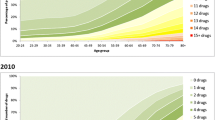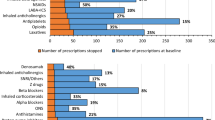Abstract
Background
Because of co-morbidity, older persons are often exposed to use of an excessive number of drugs, which per se implies also use of inappropriate drugs or of potentially interacting drugs (‘suboptimal prescribing’). Time trends of suboptimal prescribing in older, community dwellers have been poorly investigated, particularly in Italy.
Objective
To evaluate the time-course modification of suboptimal prescribing in older, community dwellers.
Methods
We conducted a study on an Italian cohort of older (aged ≥65 years), community dwellers for whom data were collected in a two-wave (1995 and 1999), population-based survey. Suboptimal prescribing was defined as occurrence of polypharmacy (≥5 medications), prescription of inappropriate medications (according to 1991 Beers’ criteria) and prescription of potentially interacting drugs (as identified by the Micromedex® Drug-Reax® system). All outcome variables were modelled as continuous and dichotomous.
Results
In 568 participants (59.9% women, mean±standard error age 72.7±0.2 years), polypharmacy and potentially interacting drugs were more prevalent in 1999 than in 1995, while prevalence of inappropriate drugs was lower in 1999. The proportion of participants receiving polypharmacy was nearly 3-fold greater in 1999 than in 1995 (21.6% vs 8.8%; p<0.001). After adjustment for disability, coronary artery disease/stroke, heart failure and other co-morbidities, polypharmacy was twice as prevalent in 1999 as in 1995, with a mean increase of 0.5 drugs per participant. In contrast, in models adjusted for the same variables and also for polypharmacy, inappropriate prescribing was reduced (60% lower prevalence, 0.06 mean reduction in prescriptions per participant) in 1999 compared with 1995. In multivariable models, no change was observed in the number of potentially interacting prescriptions.
Conclusions
Between 1995 and 1999, the number of prescriptions received by a cohort of older, community dwellers increased substantially, even after controlling for co-morbidity. On the other hand, when controlling for polypharmacy, other indicators of suboptimal prescribing remained unaffected or even decreased, suggesting that even increasing levels of polypharmacy do not necessarily imply other forms of suboptimal prescribing among older persons.






Similar content being viewed by others
References
ISTAT. L’uso dei farmaci in Italia. Rapporto nazionale anno 2004. Roma: Il Pensiero Scientifico Editore, 2005
Anderson G, Kerluke K. Distribution of prescription drug exposures in the elderly: description and implications. J Clin Epidemiol 1996; 49(8): 929–35
Tamblyn RM, McLeod PJ, Abrahamowicz M, et al. Questionable prescribing for elderly patients in Quebec. CMAJ 1994; 150(11): 1801–9
Hanlon JT, Lindblad CI, Hajjar ER, et al. Update on drug-related problems in the elderly. Am J Geriatr Pharmacother 2003; 1(1): 38–43
McLean AJ, Le Couteur DG. Aging biology and geriatric clinical pharmacology. Pharmacol Rev 2004; 56(2): 163–84
Mangoni AA, Jackson SH. Age-related changes in pharmacokinetics and pharmacodynamics: basic principles and practical applications. Br J Clin Pharmacol 2004; 57(1): 6–14
Beers MH. Explicit criteria for determining potentially inappropriate medication use by the elderly: an update. Arch Intern Med 1997; 157(14): 1531–6
Beers MH, Fink A, Beck JC. Screening recommendations for the elderly. Am J Public Health 1991; 81(9): 1131–40
Beers MH, Ouslander JG, Rollingher I, et al. Explicit criteria for determining inappropriate medication use in nursing home residents. UCLA Division of Geriatric Medicine. Arch Intern Med 1991; 151(9): 1825–32
De Wilde S, Carey IM, Harris T, et al. Trends in potentially inappropriate prescribing amongst older UK primary care patients. Pharmacoepidemiol Drug Saf 2007; 16(6): 658–67
Maio V, Yuen EJ, Novielli K, et al. Potentially inappropriate medication prescribing for elderly outpatients in Emilia Romagna, Italy: a population-based cohort study. Drugs Aging 2006; 23(11): 915–24
Fialova D, Topinkova E, Gambassi G, et al. Potentially inappropriate medication use among elderly home care patients in Europe. JAMA 2005; 293(11): 1348–58
Landi F, Russo A, Liperoti R, et al. Impact of inappropriate drug use on physical performance among a frail elderly population living in the community. Eur J Clin Pharmacol 2007; 63(8): 791–9
Onder G, Landi F, Liperoti R, et al. Impact of inappropriate drug use among hospitalized older adults. Eur J Clin Pharmacol 2005; 61(5–6): 453–9
Hanlon JT, Schmader KE, Ruby CM, et al. Suboptimal prescribing in older inpatients and outpatients. J Am Geriatr Soc 2001; 49(2): 200–9
Di Bari M, Marchionni N, Ferrucci L, et al. Heart failure in community-dwelling older persons: aims, design and adherence rate of the ICARe Dicomano project: an epidemiologic study. Insufficienza Cardiaca negli Anziani Residenti a Dicomano. J Am Geriatr Soc 1999; 47(6): 664–71
Bjerrum L, Rosholm JU, Hallas J, et al. Methods for estimating the occurrence of polypharmacy by means of a prescription database. Eur J Clin Pharmacol 1997; 53(1): 7–11
Espino DV, Bazaldua OV, Palmer RF, et al. Suboptimal medication use and mortality in an older adult community-based cohort: results from the Hispanic EPESE Study. J Gerontol A Biol Sci Med Sci 2006; 61(2): 170–5
Viktil KK, Blix HS, Moger TA, et al. Polypharmacy as commonly defined is an indicator of limited value in the assessment of drug-related problems. Br J Clin Pharmacol 2007; 63(2): 187–95
Micromedex®: Thomson DRUG-REAX® system [internet database]. Greenwood Village (CO): Thomson Reuters (Healthcare) Inc. [online]. Available from URL: http://www.thomsonhc.com [Accessed 2008 Feb]
Di Bari M, Virgillo A, Matteuzzi D, et al. Predictive validity of measures of comorbidity in older community dwellers: the Insufficienza Cardiaca negli Anziani Residenti a Dicomano Study. J Am Geriatr Soc 2006; 54(2): 210–6
Vines SK, Farrington CP. Within-subject exposure dependency in case-crossover studies. Stat Med 2001; 20(20): 3039–49
Onder G, Pedone C, Landi F, et al. Adverse drug reactions as cause of hospital admissions: results from the Italian Group of Pharmacoepidemiology in the Elderly (GIFA). J Am Geriatr Soc 2002; 50(12): 1962–8
Stuart B, Kamal-Bahl S, Briesacher B, et al. Trends in the prescription of inappropriate drugs for the elderly between 1995 and 1999. Am J Geriatr Pharmacother 2003; 1(2): 61–74
Gagne JJ, Maio V, Rabinowitz C. Prevalence and predictors of potential drug-drug interactions in Regione Emilia-Romagna, Italy. J Clin Pharm Ther 2008; 33(2): 141–51
Nobili A, Pasina L, Tettamanti M, et al. Potentially severe drug interactions in elderly outpatients: results of an observational study of an administrative prescription database. J Clin Pharm Ther 2009; 34(4): 377–86
Boyd CM, Darer J, Boult C, et al. Clinical practice guidelines and quality of care for older patients with multiple comorbid diseases: implications for pay for performance. JAMA 2005; 294(6): 716–24
Valentine C. Use computers to detect inappropriate prescriptions. BMJ 1993; 307(6895): 61
Delafuente JC. Understanding and preventing drug interactions in elderly patients. Crit Rev Oncol Hematol 2003; 48(2): 133–43
Kuijpers MA, van Marum RJ, Egberts AC, et al. Relationship between polypharmacy and underprescribing. Br J Clin Pharmacol 2008 Jan; 65(1): 130–3
Paganini-Hill A, Ross RK. Reliability of recall of drug usage and other health-related information. Am J Epidemiol 1982; 116(1): 114–22
Martin LM, Leff M, Calonge N, et al. Validation of self-reported chronic conditions and health services in a managed care population. Am J Prev Med 2000; 18(3): 215–8
Acknowledgements
No sources of funding were used to assist in the preparation of this study. The authors are very grateful to all geriatricians and general practitioners who took part in the study planning and data collection. The authors have no conflicts of interest that are directly relevant to the content of this study.
Author information
Authors and Affiliations
Corresponding author
Rights and permissions
About this article
Cite this article
Lapi, F., Pozzi, C., Mazzaglia, G. et al. Epidemiology of Suboptimal Prescribing in Older, Community Dwellers. Drugs Aging 26, 1029–1038 (2009). https://doi.org/10.2165/11319390-000000000-00000
Published:
Issue Date:
DOI: https://doi.org/10.2165/11319390-000000000-00000




